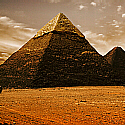Shroud of Turin
One of my college professors was part of a team that researched the shroud. I found his study most incredible and so I’ve included the topic here.
NOTE: New scientific evidence discovered in December of 2011 has shown that the image produced on the shroud was made by “an explosion of light”. And, the body “photographed” as a result on the cloth was “hovering in air” and not compressed on a table or hard surface. Incredible!
Of all evidence that exists regarding Jesus, the most remarkable and controversial by far is the Shroud of Turin. Millions of Christians believe the shroud is the burial cloth used by the disciples to wrap the body of Christ following His crucifixion. For centuries people have debated the origin of this ancient piece of faded linen that bears a mysterious image of a crucified man. Despite the reverence millions of believers pay to the shroud, skeptics reject the claims that this might be the linen burial cloth mentioned in all four of the Gospels. The critics believe that the image on the shroud is simply the result of a clever medieval artistic forger, which is not so improbable an assumption, given the fact that the medieval period produced thousands of fake relics for the curious and naive religious pilgrims who were easily fooled into believing that someone’s old bones might be the mortal remains of one of the apostles or that a piece of the true cross had miraculously survived.
However, even the critics admit that the Shroud of Turin is the most fascinating and controversial of all claimed relics. Despite hundreds of tests no one has been able to successfully explain how the mysterious image of a crucified man could have been produced by a medieval artist on the surface fibers of this linen cloth. After twenty years of testing by some of the world’s best scientists, using the most advanced scientific equipment, the mystery of the formation of the image on the shroud remains unsolved. Over one hundred and fifty thousand hours of detailed scientific testing has only deepened the mystery of how and when the astonishing image of a crucified man was formed on this ancient piece of linen. The shroud is without doubt the most extensively researched ancient artifact in the history of science. The real question is Who is the man in the shroud? Is this burial cloth a silent witness to the resurrection — the most miraculous event in history? Or is this shroud evidence of the greatest art forgery known to date?
The modern history of the Shroud of Turin began in 1357 with its first public display in a small wooden church in the forest near the tiny village of Lirey, France. The presentation of the shroud in the church produced a great deal of interest among the religious inhabitants of the province. Soon great crowds of pilgrims began to appear daily to witness this relic from the distant past that appeared to reveal an astonishing image of the crucified Messiah imprinted on its yellowed linen fibers. Although the earlier history of the shroud is indeed cloaked in mystery and legend, from 1357 on this curious cloth has captured the attention and the reverence of millions of people throughout the world. Over the centuries the shroud was often brought forth from its protected silver box to be displayed to the faithful as both a symbol and image of the Savior.
The Biblical Evidence
All four Gospels record the fact that Jesus was buried in a sindone, a linen burial cloth or shroud. This detail of Christ’s burial obviously was considered to be very important and worthy of being recorded by the Scriptures. The following passages indicate its importance:
“And when Joseph had taken the body, he wrapped it in a clean linen cloth, And laid it in his own new tomb, which he had hewn out in the rock: and he rolled a great stone to the door of the sepulchre, and departed” (Matthew 27:59–60).
“And he bought fine linen, and took him down, and wrapped him in the linen, and laid him in a sepulchre which was hewn out of a rock, and rolled a stone unto the door of the sepulchre” (Mark 15:46).
“And he took it down, and wrapped it in linen, and laid it in a sepulchre that was hewn in stone, wherein never man before was laid” (Luke 23:53).
“Then arose Peter, and ran unto the sepulchre; and stooping down, he beheld the linen clothes laid by themselves, and departed, wondering in himself at that which was come to pass” (Luke 24:12).
The disciple John, the author of the Gospel of John, records the scene when Peter and he ran to the tomb after hearing from Mary Magdalene that Christ’s body was not there:
“And he stooping down, and looking in, saw the linen clothes lying; yet went he not in. Then cometh Simon Peter following him, and went into the sepulchre, and seeth the linen clothes lie, And the napkin, that was about his head, not lying with the linen clothes, but wrapped together in a place by itself. Then went in also that other disciple, which came first to the sepulchre, and he saw, and believed” (John 20:5–8).
In this passage John alludes to the fact that there was something remarkable about the burial clothes lying on the floor of the empty tomb that convinced him that Jesus had truly risen from the dead. Is it possible that John saw an image of Christ on the linen burial cloth that proved the truth of His resurrection? Could the mysterious Shroud of Turin be “the clean linen cloth” that Joseph of Arimathea used to wrap the body of his beloved Jesus of Nazareth when he placed it in his tomb?
A Description of the Shroud of Turin and Its Significance
The Shroud is a sepia-yellow-colored linen cloth fourteen feet long and forty-three inches wide. A hand-sewn seam attached lengthwise was added to the original cloth at some unknown point of time. A faint image of the front and back of a man’s body can still be seen on the linen, but the image appears to be formed by a deeper yellowing of some of the surface linen fibers. This subtle image almost melts away as you draw near to the burial cloth. In addition, a number of carmine-or-rust colored stains that appear to be blood stains can be seen on the body image. These stains are consistent with the Gospel’s account of the scourging and crucifixion of Jesus. In addition to the image of a man, there are obvious water stains, scorch marks, and diamond-shaped repair patches that are the result of repairs made by nuns after a fire in 1532 that caused the silver box holding the Shroud to melt and burn several holes through the precious cloth.
Many skeptics have assumed that the image was painted on the cloth by a talented but unknown artist during the medieval period, in an era when literally tens of thousands of such relics — alleged pieces of the true cross, bones of the disciples, and even images of Jesus — were found in the monasteries, royal courts, and churches of every nation in Christendom. In fact, when the crusader knights returned from their brutal wars in the Holy Land, they often brought back various relics that they had stolen or purchased at great cost from the churches in the cities and villages of Israel.
On its face, the claim that an ancient object such as a linen burial cloth could actually survive throughout twenty centuries of war, pillage, and catastrophe seems almost impossible. However, museums throughout the world contain many examples of cloth that have survived for much longer than the purported age of the burial Shroud in Turin. In fact, there are examples of ancient burial shrouds from Egyptian tombs and Coptic cemeteries that predate the purported age of the Turin cloth by more than a thousand years.
Centuries later, the shroud was exhibited in Turin in 1898 to celebrate the fiftieth anniversary of the creation of the Italian kingdom. Secondo Pia, an amateur photographer, was given permission to shoot the first photographs ever taken of the shroud. To his great surprise, the negative of the black and white photograph revealed an extremely life-like image of a tall man with a strong face and striking features and surprising life-like details that could not be seen before. In general, the image revealed an anatomically correct image of a crucified man, whose wounds reflected the wounds suffered by Jesus Christ, as recounted in the Synoptic Gospels.
This intriguing photograph launched the modern period of scientific examination of the Shroud to determine if it could possibly be the genuine burial cloth of Jesus or simply the result of a brilliant artist’s attempt to depict the passion of Christ for the edification of the saints. In 1931, at another exhibition of the shroud, even more detailed photographs were taken that allowed scientists to carefully examine the image in terms of the medical evidence of the wounds that seemed surprisingly consistent with the Gospels’ record of Jesus’ crucifixion and modern medical knowledge of human anatomy.
The Medical Evidence of a Crucified Man
The first real scientific examination of the shroud began in Paris at the Sorbonne University medical school following the release of the photographs created in 1898 by Secondo Pia. Yves Delage, a brilliant professor of comparative anatomy,  undertook detailed studies of the physiology of the body image, as well as the evidence of pathology derived from the details of the wounds found in the image of the crucified body. As an atheist, Delage was astonished to find that the image displayed a remarkably accurate anatomic depiction of a dead male, whose body had been both whipped and crucified and showed evidence of rigor mortis. The multiple whip wounds and the resulting blood flow from the scourgings, puncture wounds in the head, spike wounds through the wrists and feet, and a wound in the man’s right side were all consistent with the Gospel record of Jesus Christ’s crucifixion.
undertook detailed studies of the physiology of the body image, as well as the evidence of pathology derived from the details of the wounds found in the image of the crucified body. As an atheist, Delage was astonished to find that the image displayed a remarkably accurate anatomic depiction of a dead male, whose body had been both whipped and crucified and showed evidence of rigor mortis. The multiple whip wounds and the resulting blood flow from the scourgings, puncture wounds in the head, spike wounds through the wrists and feet, and a wound in the man’s right side were all consistent with the Gospel record of Jesus Christ’s crucifixion.
A scientific analysis reveals a naked, well-formed, muscular adult male in his thirties. He has a mustache, full beard, and shoulder-length long hair that appears to be tied back behind the head. Such a hair style and length are consistent with what we know of Jewish customs of the Second Temple period. The body measures approximately 5 foot 10 inches in height, with a weight estimated to be about 175 pounds, which is about average for Jewish males of the first-century, according to recent excavations in Israel. Harvard professor Carleton Coon has described the physical appearance of the man in the shroud as being “of a physical type found in modern times among Sephardic Jews and noble Arabs”
The image of the body reveals as many as one hundred and twenty wounds, each approximately one and one-half inches long on the back, arms, and shoulders. They appear to be produced by dumbbell-shaped objects and are consistent with wounds formed by the Roman whip, known as the flagrum. The flagrum was a brutal multiple-thonged whip with lead or bone dumbbell-shaped weights attached to the ends of the whip that would tear the skin and flesh. While some critics have pointed out that ancient Jewish law prohibited giving a prisoner more than forty strokes with a whip, Roman law did not limit the number of times prisoners could be whipped. While some critics and skeptics have suggested that Jesus did not die on the cross, the evidence from the shroud indicates that the man may have been near death from the repeated whippings, even before he suffered the brutality of crucifixion. Scientists have noted that the shoulders appear to be severely bruised and the blood stains from whip wounds are distorted by something having rubbed against the shoulders. This may be explained by the Gospel account that Jesus was forced to carry the cross, which would have produced such bruising. In addition, the various wounds on the knees of the man in the image may reflect what would have happened to Jesus as He stumbled and fell repeatedly while carrying the cross on the way to Golgotha.
Some critics have complained that the evidence from the wounds in the image suggests that the body had not been washed, contrary to ancient Jewish burial practices that required the body to be washed before burial. However, the urgency to bury the body before the commencement of the Sabbath may have prevented the normal washing. However, a Jewish scholar, Prof. Victor Tunkel of London University, has pointed out that Jewish practice would actually have prohibited the washing of a body of a person who was violently killed to ensure that his blood would remain with the body in anticipation of the future bodily resurrection. Even today in Israel ultra-Orthodox religious groups carefully gather the bodily remains and blood of victims of terrorist bombs to bury such items with the body. The fact that the body was unwashed argues that the shroud is genuine.
Another remarkable aspect of the burial cloth is that the blood flow from the wrist indicates that the spike was placed through the wrist of the man in the shroud and not through the palm, as we find depicted on countless religious paintings of Christ on the cross. Dr. Pierre Barbet performed numerous experiments with cadavers and amputated arms to demonstrate that a spike through the palm would not hold any body weighing more than 90 pounds. However, by nailing the spike through the opening between the bones in that part of the wrist known as the “Space of Destot,” the spike would fully support the weight of an adult male body, exactly as we find in the image on the shroud.
Israeli archeologists recently discovered an ossuary or stone coffin at Giv’at ha-Mivtar, near Jerusalem, that contained the body of a male who had been crucified. The spike was still in place through both feet, and the spike that held the arms had been placed through the Space of Destot. The legs of the crucified man, specifically the fibula and the right and left tibia, had been broken to hasten his death, exactly as had happened to the two thieves who were crucified on either side of Jesus, according to the Gospel of John.





